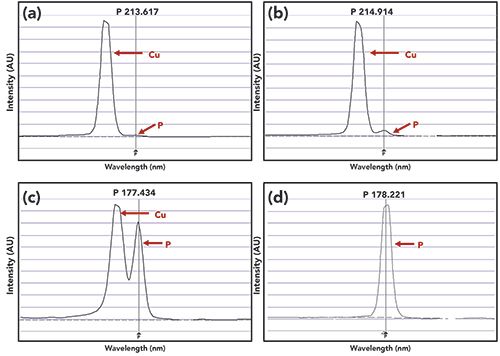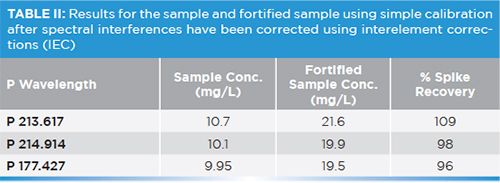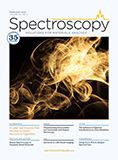Influence of Spectral Interferences on the Reliability of Data When Using Analyte Addition Techniques with ICP-OES
Spectroscopy
Contrary to popular belief, neither good “spike” recoveries nor the use of the method of standard additions (MSA) will guarantee accurate results in ICP-OES.
A common misconception among users of inductively coupled plasma optical emission spectrometry (ICP–OES) is that good “spike” recoveries automatically indicate that the original sample results are accurate. Another common misconception is that the use of method of standard additions (MSA) as a means of calibration to correct for interferences will also always produce accurate results. This tutorial shows that neither of these techniques will produce accurate results if the interference is from spectral overlaps that have not been corrected by other appropriate means.
When using any atomic spectroscopy technique for elemental analysis, it is easy to obtain results. Validating that the results are accurate is not always so easy. There are many practices used to help validate that results are accurate. The analysis of calibration verification solutions, reference materials, interference check solutions, samples prepared in duplicate, and analyte addition techniques are some ways used to verify the data is accurate.
There are two types of analyte addition techniques commonly used in atomic spectroscopy. The first is to fortify a portion of a sample with a known additional concentration of analyte, or what is termed to “spike” the sample. There are also times when, instead of using simple calibration standards and reading the analyte concentration from the calibration curve, a technique of method of standard additions (MSA) is used. In this scenario, the calibration curve is achieved in the presence of the sample matrix.
There are three basic types of interferences that can be experienced using this inductively coupled plasma optical emission spectrometry (ICP-OES): 1) physical interferences that have to do with how much sample is transported into the plasma with each solution analyzed; 2) interferences from the sample matrix having an effect on the population of excited atoms and ions within the plasma; and 3) spectral interferences where something other than the analyte of interest produces spectra different from the plasma at the measured wavelength. Acceptable spike recoveries (typically 85% to 115% in a real sample matrix) is a good indicator of physical and matrix interferences. Using MSA can help alleviate both of these problems. What neither of the techniques properly addresses are spectral interferences.
Unfortunately, a common mistake is believing that achieving good “spike” recovery or obtaining results using MSA is a guarantee for reporting accurate results. While obtaining poor spike recoveries is an indicator of results that are probably not accurate, good recoveries do not guarantee compensation for all types of interferences. While using MSA rather than simple calibration can compensate for some types of interferences, it does not compensate for all interferences for the same reason. Neither of these techniques will indicate or compensate for spectral interferences.
Experimental
To show the problem, the determination of phosphorus in the presence of a high concentration of Cu is used as an example. Two very commonly used phosphorus wavelengths, 213.617 and 214.914, both suffer from overlaps from nearby copper wavelengths, 213.597 (and 213.599) and 214.898, respectively. A third wavelength, 177.434, also will show overlap from Cu 177.427. The P 178.221 wavelength does not suffer from this same problem. In this study, the P 178 wavelength is used as a control.
A method was set up for the determination of P at the four wavelengths cited above. Calibration was achieved using standards prepared in 1% HNO3 at 5, 10, and 20 mg/L P. All calibration curves had correlation coefficient of 0.998 or 0.999 with linear regression type curve. A solution containing 10 mg/L P and 200 mg/L Cu was analyzed. A portion of this sample was then spiked with an extra 10 mg/L P, and analyzed.
MSA was then used for sample analysis. Four portions of the sample were spiked with the calibration blank and the three standards, 5, 10, and 20 mg/L, to achieve calibration. Correlation coefficients were again 0.998 and 0.999 for the wavelengths used.
Results
Generally, acceptable “spike recoveries” are considered to be within 15%. When the sample and its spike were analyzed, the recoveries were calculated. The results are shown in Table I. Calculated spike recoveries for all the wavelengths fall within acceptable (15%) criteria. However, the only wavelength to show correct results for the known concentration of 10 mg/L is P 178.221. The results for the sample when using MSA are also shown in this table. When using MSA, that is also the only wavelength to show correct results.

The problem is that Cu provides a spectral interference on all wavelengths except the P 178, contributing to the P concentration, and this has not been compensated. Figure 1 shows examples of the spectral peaks for the unknown at the four wavelengths. Only P 178.221 is free from the spectral overlap.
Figure 1: Spectra for the sample containing 10 mg/L P and 200 mg/L Cu for the four wavelengths used for this study: (a) P 213.617, (b) 214.914, (c) P 177.434, and (d) P 178.221.

To correct for the spectral overlaps, interelement correction was applied for the P 213, P 214, and P 177 wavelengths. Simple calibration was once again used and not MSA. Table II shows the corrected data for these wavelengths. Now all wavelengths are in concentration agreement of the known value of 10 mg/L, as well as good recoveries of the fortified portion of the sample.

Conclusion
It is important for the analyst to use all quality control tools when analyzing sample with complex matrices. Good spike recoveries and using MSA alone may end up in the reporting of inaccurate data. Analyte addition techniques are helpful for compensation of physical and matrix issues, but are not sufficient for correcting for spectral interferences. Viewing the spectral data is a good troubleshooting tool to determine if these problems exist and need further correction for the wavelengths chosen.
Deborah Bradshaw is an analytical chemist who has been working the field of atomic spectroscopy for over 35 years. For the past 20 years, she has been working as a consultant in the field of atomic spectroscopy, conducting training classes and giving technical support for atomic absorption (AA) spectroscopy, inductively coupled plasma-optical emission spectroscopy (ICP-OES), and inductively coupled plasma-mass spectrometry (ICP-MS). Direct correspondence to: bradshawdk@cs.com

FT-IR Microscopy, Part 2: Mid-IR Sampling with DRIFTS, IRRAS, and ATR
February 14th 2025Fourier transform infrared (FT-IR) microscopy using reflection methods (diffuse reflection, reflection/reflection-absorption, or attenuated total reflectance) typically requires less sample preparation than transmission. However, optimal results will depend upon the sample and, in particular, the sample surface.
Key Points to Remember When Using Internal Standards for Sample Analysis by ICP-OES
August 2nd 2023Using internal standards is a common technique to correct for variations in sample matrices and the effect this has on analyte intensities. There are several basic criteria to be considered when using internal standards: selection of appropriate internal standards, the concentration added to the solutions analyzed, setting up in the correct view (axial vs. radial), how to introduce the internal standard to the solutions to be analyzed, and evaluating the resulting data. Each of these topics are considered and suggestions presented.
A Brief Look at Optical Diffuse Reflection (ODR) Spectroscopy
August 1st 2023In this short overview, we consider cases for diffuse reflection spectroscopy and introduce the Kubelka-Munk diffuse reflectance formula. We conclude by comparing diffuse transmittance, diffuse reflectance, logarithmic transforms of both, and the Kubelka-Munk transform for mid-infrared spectroscopy of the same sample.
Key Steps to Follow in a FRET Experiment
August 1st 2022Förster resonance energy transfer (FRET) is a versatile part of the toolbox of fluorescence methods. This through-space, photon-less energy transfer process between a donor fluorophore and an acceptor chromophore is perhaps most famous for its utility as a “molecular ruler” that can resolve nanometer-scale distances. FRET is also a popular and advantageous basis for biomolecular assays and sensors.